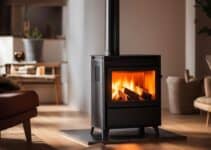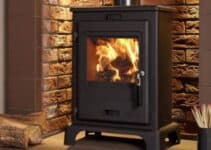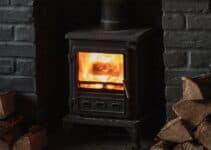Wood burners have a long history. Wood burning stoves were, according to historical records, originally used in the 1500s. They’re still used to generate heat throughout the world today.
Wood burners are particularly widespread in the United States in locations where the winters are chilly. Wood burners are far more effective than ever before, making them a great alternative to an electric or gas furnace.
But do wood burners smell? Wood burners do smell and nothing beats the aroma of a wood burning stove in operation, especially if you’re using an exceptionally aromatic wood. However, if your wood burner begins to emit strange or foul odours, it can be alarming as well as unpleasant.
In this article, we are going to look at why wood burners smell, the different types of smells, and how to stop smoke and smells.
Can You Smell A Wood Burning Stove?
Wood burning stoves usually have a great aroma. However, sometimes wood burning stoves may emit a foul odour.
Several things interact with how effectively your fire burns and how your stove performs, all of which can lead to a smelly fireplace or stove.
Unusual odours emanating from your wood-burning stove are usually the consequence of an issue with the fuel or a lack of draft, which prevents dampness, soot, or fumes from exiting your home.
A clogged chimney or flue, insufficient fire ventilation, or even the climate might cause a poor draft.
When a wood-burning stove emits too much smoke, it can stink. Whenever the material in a fire isn’t burned appropriately, smoke is produced.
Fire requires both fuel and oxygen to thrive, therefore excessive smoke from a fire can indicate either a problem with the wood or a problem with the fire’s air supply.
Why Does My Log Burner Smell?
There are a variety of elements that determine how effectively wood burns in a fire, such as the wood’s moisture content. If the moisture content of the wood is too high, logs might burn improperly and raise the probability of smoke production.
Let’s look in more detail at some of the reasons why wood burners can smell:
New Log Burner Smells
Before they can attain their highest productivity in supplying heat to your house, each newly installed wood burning stove will require a ‘break-in’ period.
Each manufacturer will have different specifications for the number of fires needed, as well as the size and duration of the fire. For more information on how to break in your stove, consult the manufacturer’s instruction book.
A chemical stench may be detected during the break-in phase of your wood burning stove, which is caused by the paint curing on the stove while it is used for the first few times.
The odour arises from the liquids evaporating while the paint cures at high temperatures.
This is quite typical for any stove, and you shouldn’t be concerned. Continue to use your stove to finish the break-in time, and the odour should go away.
It’s a good idea to break it in on a milder day where you can open your windows to let the pong out.
Chimney or Flue Blockage
A dirty chimney or flue impedes smoke and gases from freely exiting your property, causing your wood burning stove or fireplace to stink.
Lighting a log burner and burning wood produces soot and creosote, which can accumulate over time in your chimney or flue. Burning wood with a high moisture content can hasten the formation of soot and creosote by causing the fire to smoke more than usual.
A soot and creosote-lined chimney or flue will effectively restrict the size of its aperture, making it less efficient at removing air from your fireplace or stove than one that has just been cleaned.
Any downdraft inside your chimney or flue can spread the log burner smell of soot and creosote into your home.
Bird nests or other material such as leaves and moss can also potentially cause a blocked chimney or flue.
Polluted Wood
This may seem odd, but a number of individuals have experienced weird odours coming from their stoves as a result of burning wood that has absorbed leftover fumes from vehicle exhausts.
Wood that is stored in garages can absorb exhaust fumes over time. If you use wood from the top of stacked logs in your garage on a regular basis, you may not have yet met the problem of polluted logs emitting a weird odour.
Wood from the bottom of the pile that has been there for a long time and has been subjected to exhaust fumes on a regular basis may bring exhaust type smells into your living room when burned.
Wet Wood
A likely explanation of a wood burning fireplace or wood stove smoking and/or stinking is burning wood with too much moisture content.
The greater the level of moisture, the greater the effort needed by the fire to burn up the surplus water.
Before the fire can adequately burn the wood to produce heat, the excess moisture content must be burned out.
Burning off the extra moisture might cause the fire to emit smoke, which can lead to soot and creosote being released up the chimney or flue. The soot and creosote can accumulate there, leaving a lasting odour coming from your stove.
Only burn well-seasoned or kiln-dried wood to avoid the unpleasant odours created by excess moisture, soot, and creosote. To help reduce the discharge of smoke and other particles from a fire, wood with a moisture level of 20% or less is advised.
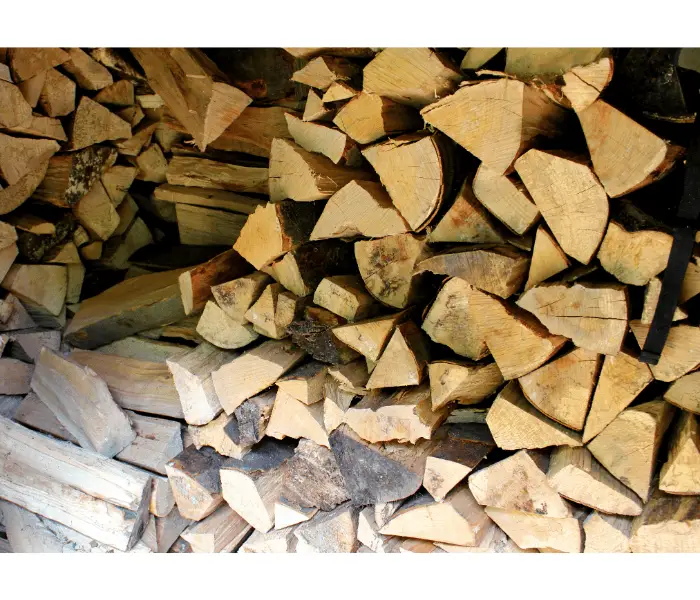
Inadequate Ventilation
Consider your wood-burning stove or fireplace as a conduit for air to flow from your home to the outside.
The air vacuumed up your chimney or flue needs to be replenished with clean air from the area. Negative pressure can be formed in your home if there is inadequate ventilation to replace the air vacuumed out, which reduces the pull on your stove.
Inadequate ventilation in your home might cause your wood burning stove to smoke, preventing the smoke from exiting your home and resulting in lingering aromas.
Negative air pressure in your home can be exacerbated by a newer, more tightly sealed home, or by extractor blowers sucking air out of your home, such as in the bathroom.
To get around this, leave all of the room’s doors open.
Insufficient Chimney Size
An undersized chimney can lower the efficiency with which waste smoke and gases are removed from your property when compared to the size of your stove.
In general, taller chimneys provide a stronger pull to your fireplace than shorter chimneys.
An inadequate chimney could be the source of smoke odours coming from your stove. A chimney extender can be used to extend the length of your chimney to ensure adequate suction for your wood burner or fireplace.
How Do I Stop My Wood Burning Fireplace From Smelling?
Below are a few tips to help stop your wood burning fireplace from smelling.
- If you have a new wood stove, burn it for a few minutes to get rid of any paint aromas.
- Only use low moisture content, well-seasoned or kiln-dried wood to start a fire.
I recommend Amos:
- On colder days, preheat the air in the flue or chimney using a heat source before using your stove.
- Do not use your stove if the weather is windy.
- Open internal doors to neighbouring rooms or open windows and vents to the outside to ensure that the room has appropriate ventilation.
- Have your chimney swept once a year at the very least.
How Long Will A New Wood Burner Smell?
A new wood burning stove would normally require about one to three burns before it is properly broken in and the paint has cured and the new log burner smell has vanished.
In the operating manual, your manufacturer will explain how to actually break in your specific kind of wood stove, as well as how many burns it will take to finish this process.
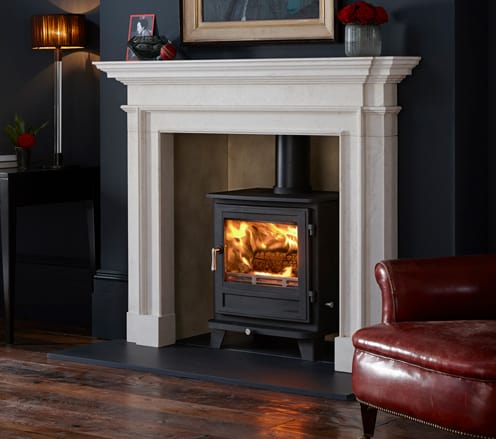
Why Does My Wood Burner Smell Like Burning Plastic?
Your wood stove (once it is broken in) ought to smell like it’s burning wood, not like it’s burning plastic. If you detect a characteristic odour of burnt plastic when your stove is in operation, it’s critical that you discover what’s causing it as soon as possible.
The fact that your wood stove smells like burning plastic does not imply that the stench is caused by burning plastic.
Here are some reasons why you may be getting that plasticky smell –
The stove has plastic on it or near it
Your issue could be as simple as a plastic object being too near to your stove and burning.
Look for these common culprits on, in, under, around, and behind your stove:
- Toys for your dog or cat
- Toys for kids.
- Pens
If you put paper to help start your stove, some of this may be coated with plastic.
Burning Chemically-treated wood
It is possible that the plastic scent comes from burning wood that has been treated with chemicals. Chemically treated wood, commonly referred to as “pressure-treated” wood, is utilised in construction and industry.
The treatment considerably improves the wood’s durability, which is why it’s frequently preferred over untreated wood.
Chemically treated wood should never be burned. The chemical vapours are hazardous and can cause a variety of health problems.
Burning Fungus-infested wood
Although fungus is not plastic, the odour of burning fungus can be mistaken for that of burning plastic.
Examine your wood before putting it on the fire. Remove any fungi-infested sections – or use a different bit of wood entirely – and see if the odour continues.
It’s worth noting that burning fungus isn’t inherently dangerous, and it’s fine to do if you don’t mind the scent. If you have a mould allergy, however, you should avoid burning fungus-infested wood, as well as any older or wet wood.
Dust
If the scent appears when you first operate your stove after at least a month of inactivity, it could be due to the stove burning up dust that has collected.
The stove and chimney pipe are constantly gathering dust. Because the amount burned off is so small to generate a detectable stench, you won’t notice it if you use your stove regularly.
Keep a dedicated duster nearby to dust around the wood burning stove before and after each use:
However, if you haven’t used the stove in a while, there’ll be enough dust to smell. Burning dust is common and should not be a cause for concern. If the odour goes away after a few uses of the stove, dust is most likely to blame.
Wood Stove Smells When Not in Use
A wood stove may emit an unpleasant smell even when it’s not in use due to several reasons:
Residual creosote: Creosote is a byproduct of wood combustion that can build up inside the stove and chimney over time. Regular cleaning and maintenance can help reduce creosote buildup and its associated smell.
Ash and debris: If you have not cleaned your wood stove thoroughly, ash and debris can accumulate and produce a smell over time. Regularly clean your stove and remove ash to minimize odors.
Animal or bird nests: Sometimes, animals or birds may build nests in the chimney, which can lead to unpleasant odors. Inspect your chimney regularly and install a chimney cap with a mesh screen to prevent animals from entering.
Draft issues: Poor draft or a closed damper can cause stale air and odors to become trapped inside the stove and chimney. Ensure proper ventilation and open the damper when necessary.
To reduce unpleasant smells from your wood stove when it’s not in use, make sure to clean and maintain the stove and chimney regularly, address any moisture issues, and ensure proper ventilation.
Do Wood Burners Smell of Smoke?
Wood burners can emit a smoke smell when in use, primarily due to incomplete combustion of wood, which releases smoke particles and gases. Properly seasoned wood, good airflow, and regular maintenance help reduce smoke odors.
However, if a wood burner is not adequately vented or if creosote has built up inside the stove or chimney, the smoke smell may become more noticeable. Ensuring your wood burner is clean, well-maintained, and properly vented can minimize any unpleasant smoke odors.
Wood Stove Smells Like Burning Dust – Why?
A wood stove smelling like burning dust can be attributed to several factors:
Dust accumulation: Over time, dust and other debris accumulates on the stove’s surfaces, especially if it’s not been used for a while. When you light the fire, the dust burns off, producing a distinct burning dust smell. Regular cleaning and maintenance can help prevent this issue.
Creosote buildup: As mentioned before, creosote is a byproduct of wood combustion, which can build up on the walls of your stove and chimney. If creosote deposits are burning, they can produce a similar smell to burning dust. To prevent creosote buildup, use seasoned wood, maintain proper air circulation, and clean your stove and chimney regularly.
New stove or paint: If you have a new wood stove or have recently painted it, the smell could be coming from the curing process of the paint or protective coatings. The smell should dissipate after a few fires as these materials cure completely.
Burning foreign materials: Make sure you’re not burning anything other than wood in your stove. Burning materials like plastics, treated wood, or garbage can produce harmful fumes and unpleasant smells, including a burning dust odor.
To address the issue, ensure proper cleaning and maintenance of your wood stove, including the stovepipe and chimney. Also, use seasoned, dry wood, and avoid burning foreign materials. If the smell persists, consult a professional chimney sweep for an inspection and cleaning.
Do Log Burners Smell
Log burners do have a smell both inside and outside, but its very mild and its the smell of burning wood. Wood burners are a wonderful addition to many homes, a sure-fire winner (if you’ll pardon the pun) to make a room feel cosy and romantic. They look fantastic and should smell fantastic.
If they don’t, then there are things you can do to get them smelling as sweet as they look. If it is your neighbours woodburner that smells, you may have grounds to complain.


